A breakthrough for second-generation biofuels
on
A breakthrough for second-generation biofuels
Dutch companies have developed a new technology that could become a breakthrough in the use of wood residues in electricity generation. By perfecting the so-called torrefaction process, they are able to achieve industrial-scale production of “bio-coal” pellets that can be used as a perfect substitute for coal in coal-fired power plants. RWE Innogy, the renewable energy subsidiary of the giant German utility RWE, has invested several millions in the technology. RWE Innogy is now building a €120 million wood pellet plant for the production of biomass pellets in Georgia in the US, which is likely to use torrefaction in the future. According to Leonhard Birnbaum, Board Member of RWE, the new product has the potential ‘to decarbonise our existing coal power infrastructure’.
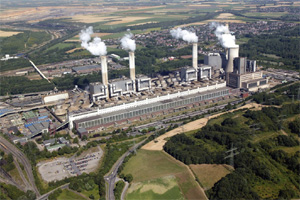 |
| This RWE Coal fired plant might run on "bio-coal" in the future. Photo: RWE |
But the investment of RWE Innogy in Dutch technology company Topell dates from two years ago, i.e. well before RWE’s takeover of Essent. In fact, it was the very first venture capital investment that RWE Innogy ever made. ‘The event today shows that our decision to invest in Topell was right’, said Birnbaum. ‘Our intention’, he added, ‘was to commercialise a new process for the production of efficient bio-coal, which significantly improves and extends the potential applications of biomass.’
The process Birnbaum referred to is called torrefaction, a thermo-chemical treatment of biomass that removes water and volatiles from the raw material and ultimately produces a solid fuel that resembles coal and is therefore called bio-coal. In the Netherlands this technology is far advanced, in part thanks to the activities of research institutions such as ECN (Energy Research Centre of the Netherlands) and KEMA. ECN has built a demonstration plant together with Vattenfall. Patrick Bergman of ECN, one of the foremost torrefaction experts in the world, is joining Topell, which is one of four Dutch companies that are currently building torrefaction plants. The other ones are FoxCoal, Torr-Coal Technology and Stramproy Green Technology. FoxCoal, Torr-Coal and Topell have together formed the Dutch Torrefaction Association.
Whole world
According to Ewout Maaskant, CEO of Topell Energy, his newly to be built factory in Duiven is ‘one of the first and largest torrefaction plants in the world’. He expects Topell’s production capacity to be scaled up to 80,000 or even 100,000 tons. ’60,000 tons is just a first step’, he notes. ‘Torrefaction is new. It can be employed at scale. We are in a hurry.’
A case study from consultancy DHV and the University of Groningen shows that the CO2-emissions from the entire production chain that Topell uses are 49 grams per ton. This compares to 760 grams CO2 per ton for traditional coal-fired power production, says Maaskant. The costs of the bio-coal pellets will be roughly equivalent to €7.50 per Gigajoule, which compares to current prices of €4.50-5.00 per Gigajoule for coal-fired power, but this excludes CO2-costs. The Topell factory gets a €1 million subsidy from the government, but this money is intended only to enable the use of very low-grade – and usually very wet – biomass, such as grass, in the torrefaction process. In addition, the electricity producer who uses the bio-coal, in this case Essent, receives a subsidy of €61 per MWh from the Dutch government for producing this “green electricity”.
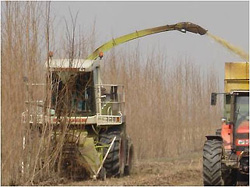 |
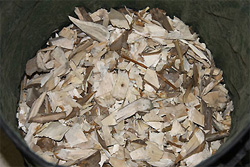 |
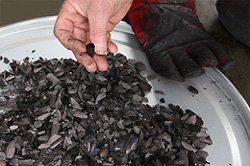 |
| The creation of bio-coal: First the biomass (in this case poplar trees) is harvested. Then the chips undergo a process called torrefaction. The treated biomass can then be pressed into pellets. |
Too limited
Birnbaum notes that the bio-coal pellets produced with the torrefaction process have several major advantages. ‘The process developed by Topell enables the continuous production of bio-coal pellets on an industrial scale. The manufacturing process is highly flexible in terms of raw material input. The bio-coal pellets have a significantly higher density and caloric value than woodchips and much more homgeneous combustion properties. This is why they can easily be transported, stored and burned with coal.’
Thanks to their unique properties, the bio-coal pellets require no additional, costly infrastructural measures, such as separate storage or pulverisation, when co-fired with conventional coal. For RWE this is a particularly important consideration, since the company is one of the largest coal-power producers in Europe and is looking for ways to reduce its CO2 emissions. Hence, Birnbaum says that ‘this technology can decarbonise our existing infrastructure.’
Birnbaum’s assessment was confirmed by Essent-CEO Peter Terium, who had some news of his own on Monday. He announced that Essent had carried out a successful test in which the Amer coal-fired power plant in the Netherlands used 50% biomass. ‘It is the first time in the world that a coal-fired
|
‘If you look at economics, biomass simply scores better’ |
But for RWE, with its huge power generation capacity, the ability of the Netherlands to deliver bio-coal is much too limited. Regions like North America and Eastern Europe have of course much more raw material available. That is why RWE Innogy is now building what is one of the largest plants for the manufacture of biomass pellets in the world – in Georgia in the US. This has a capacity of 750,000 tons and will cost €120 million. The wood pellets produced in Georgia will find its way to RWE’s many coal-fired power plants in Europe.
|
Biomass can’t be missed
According to the RWE-executive, biomass has important advantages over other renewable energies. ‘It can be used at a large scale. It is reliable, in the sense that it does not depend on intermittent sources like the wind or the sun. It can be used as a direct substitute for coal. And what is also very important, it can be used not just for electricity, but also for heating.’ But most important of all, says Birnbaum, ‘biomass is the most economic form of renewable energy. If you look at economics, biomass simply scores better. If we are serious about reducing CO2 emissions at affordable costs, biomass needs to be part of the solution.’ Birnbaum is critical of the massive subsidies the German government puts into photovoltaic power. ‘This way you achieve much less with much more money.’ He gets support from Jurriaan Ruys, Partner of McKinsey, who also spoke at the opening ceremony in Duiven. According to Ruys, ‘biomass will be necessary to achieve the EU’s 20/20/20 targets. It can’t be done with wind, wave and solar power alone’. Ruys says the use of biomass in power production in Europe must at least be doubled by 2020 from 800 TWh to 1600 TWh if the EU is to achieve its targets. He thinks that a cost reduction of 15 to 40% is still possible. He also points out that heavy trucks, planes and ships cannot be run on batteries. But Ruys acknowledges that biomass has its problems. ‘Mankind has used biomass for thousands of years, but so far it has not been used at scale. Then the supply chain is very fragmented. The demand picture is uncertain. And there have been issues with land use and biodversity. So there is still a long way to go.’ |


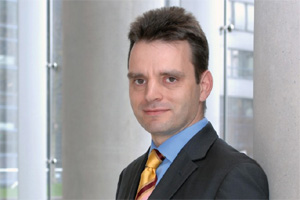
Discussion (0 comments)